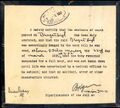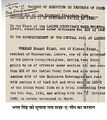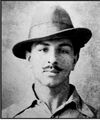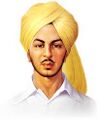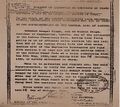Bhagat Singh Sandhu
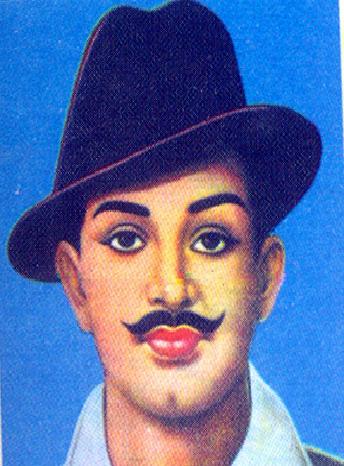

Shaheed Bhagat Singh Sandhu (September 28,[1] 1907 - March 23, 1931) was a famous freedom fighter, He is also considered as one of the most famous revolutionaries Of the Indian Independence Movement. For this reason, he is often referred to as Shaheed-i-Azam Bhagat Singh (the word shaheed means "martyr"). He is also believed by many to be one of the earliest Marxist thinkers in India.[2] He was one of the founders of the Hindustan Socialist Republican Association (HSRA).
Revolutionary Bhagat Singh
Born in a family which had been involved in revolutionary activities against the British Raj in India, Bhagat Singh, as a teenager, had studied European Revolutionary Movements and was attracted to anarchism and communism.[3] He became involved in numerous revolutionary organizations. He quickly rose in the ranks of the Hindustan Republican Association (HRA) and became one of its leaders, converting it into the HSRA. Singh gained wide spread support when he underwent a 63 day fast in jail, demanding equal rights for Indian and British political prisoners. He was hanged for shooting a police officer in response to the killing of veteran social activist Lala Lajpat Rai. His legacy prompted youth in India to begin fight for Indian independence and also increased the pace of the rise of socialism in India.[4] He is a very popular public figure in Pakistan as well.[5] Recently, to honour the revolutionary, a busy round-about has been named after him, adjacent to the Lahore central jail where Bhagat Singh was hanged along with Rajguru and Sukhdev, by the Britishers.[6]
Brief life Sketch

On September 28, 1907, Bhagat Singh was born into a Sandhu family to Sardar Kishan Singh Sandhu and Vidyavati in the Khatkar Kalan village near Banga in the present Nawanshahr district in Punjab. [7][8][9][10] of Punjab. Singh's given name of Bhagat meant "devotee". His family background was that of a patriotic Sikh family which had participated in numerous movements supporting independence of India.[11] His father was influenced by the Hindu reformist Arya Samaj. His uncles, Sardar Ajit Singh and Swaran Singh, as well as his father were both part of the Ghadr Party led by Kartar Singh Sarabha. Ajit Singh was forced to escape to Iran because of pending cases against him while Swaran Singh was hanged.[12][11]
As a child, he was deeply affected by the Jalianwala Bagh Massacre that took place in Punjab in 1919.[12] When Mahatma Gandhi started the Non-Cooperation Movement in 1920, he became an active participant at the age of 13. He had great hopes that Gandhi would bring freedom in India. But he was disappointed when Gandhi called off this movement following the Chauri Chaura riot in 1922. At this point he had openly defied the British and had followed Gandhi's wishes by burning his government-school books and any British-imported clothing. In 1923, Bhagat famously won an essay competition set by the Punjab Hindi Sahitya Sammelan. This grabbed the attention of members of the Punjab Hindi Sahitya Sammelan including its General Secretary Professor Bhim Sen Vidyalankar. At this age, he quoted famous Punjabi literature and discussed the Problems of the Punjab. He read a lot of poetry and literature which was written by Punjabi writers and his favourite poet was an Indian freedom fighter Allama Iqbal from Sialkot.[13]
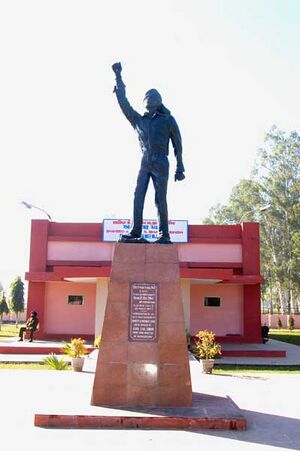
In his teenage years, Bhagat Singh started studying at the National College in Lahore,[12] but ran away from home to escape early marriage, and became a member of the organization Naujawan Bharat Sabha (Translated to 'Youth Society of India').[12] In the Naujawan Bharat Sabha, Singh and his fellow revolutionaries grew popular amongst the youth. He also joined the Hindustan Republican Association at the request of Professor Vidyalankar, which was then headed by Ram Prasad Bismil and Shahid Ashfaqallah Khan.[12] It is believed that he had knowledge of the Kakori Train Robbery. He wrote for and edited Urdu and Punjabi newspapers published from Amritsar.[12] In September 1928, a meeting of various revolutionaries from across India was called at Delhi under the banner of the Kirti Kissan Party. Bhagat Singh was the secretary of the meet. His later revolutionary activities were carried out as a leader of this association. The capture and hanging of the main HRA Leaders also allowed him and Sukhdev to be quickly promoted to higher ranks in the party.[11]
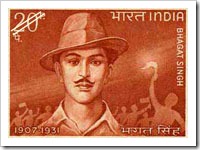
Bhagat Singh was hanged with two other revolutionaries - Sukhdev and Rajguru - March 23, 1931 for their involvement in what came to be known as the Lahore Conspiracy Case.
Postal stamp
शहीद भगत सिंह के नाम पर पाक का लाहौर चौक
लाहौर -पाकिस्तान ने लाहौर के शादमन चौक का नाम बदलकर शहीदे आजम भगत सिंह के नाम पर कर दिया है। इस चौक के पास कभी लाहौर की सेंट्रल जेल होती थी। वहीं 23 मार्च 1931 को भगत सिंह, राजगुरु और सुखदेव को फांसी दी गई थी। साल 1961 में इस जेल को ध्वस्त कर दिया गया। वहां शादमन कालोनी बनाई गई। शादमन चौक पर हर साल 23 मार्च को दोनों देशों के लोग यहां मोमबत्ती रैली निकालते हैं। भारत-पाकिस्तान दोस्ती मंच से जुड़े लोगों और भगत सिंह के परिजनों ने इस चौक का नाम बदले जाने का स्वागत किया है। [14]
जीवन दर्शन: जब भगतसिंह ने किया कर्ज माफ
विख्यात क्रांतिकारी भगतसिंह अपनी दयालुता के कारण भी जाने जाते हैं। निर्धनों के प्रति उनके हृदय में अपार दया थी और यदि कोई गरीब मदद के लिए उनके पास आता तो वे मदद करने का यह मौका कभई नहीं छोड़ते थे। उन्होंने स्वयं भी गरीबी को भोगा था, इसलिए अपनी आर्थिक स्थिति में सुधार आने के बाद वे गरीबों की मदद करने लगे। भगतसिंह के परिवार के पास कुछ खेत थे। उनमें काम करने वाले मजदूर निर्धन थे। भगतसिंह उनसे मालिक-नौकर वाला व्यवहार नहीं रखते थे। उनके साथ बराबरी का व्यवहार करते और उनके संकट की घड़ी में उनके साथ कंधे से कंधा मिलाकर खड़े होते थे। जब वे मजदूर भोजन करने बैठते, तो भगतसिंह को उनका खाना देखकर बहुत दु:ख होता था। वे देखते थे कि मजदूर रुखी-सूखी रोटी खा रहे हैं। तब भगतसिंह उनके भोजन में कुछ चिकनाई वाली व स्वादिष्ट वस्तुएं मंगवाकर शामिल कर देते थे। गाहे-बगाहे रुपए-पैसे से भी यथाशक्ति उनकी सहायता करते थे। एक बार मंगलसिंह नामक मजदूर के विषय में भगतसिंह को मालूम पड़ा कि उस पर तीन हजार रुपए का कर्ज हो गया है और वह कर्ज भगतसिंह से ही लिया गया था। इस कर्ज का अधिकांश हिस्सा उसने परिवार में होने वाली शादियों में लिया था। मंगलसिंह की निर्धनता को देखते हुए भगतसिंह ने उसका सारा कर्ज माफ कर दिया और उसे समझाया कि भविष्य में वह कर्ज लेकर झूठी शान दिखाने का प्रयास न करे। मंगलसिंह जीवन भर के लिए भगतसिंह का ऋणी हो गया। भगतसिंह के जीवन के इस प्रसंग का सार यह है कि यदि हम अपनी आय का एक छोटा-सा हिस्सा भी निर्धनों के लिए व्यय करें तो देश का बड़ा तबका निर्धनता से मुक्त हो सकता है।[15]
स्मृतियां शेष – 23 मार्च शहीद भगत सिंह
गाँव शादीपुर तहसील खैर जिला अलीगढ़ उत्तर प्रदेश
शादीपुर तहसील खैर, जिला अलीगढ़, उत्तर प्रदेश, जट्टारी-पिसावा मार्ग पर नहर किनारे स्थित एक गाँव है। गाँव में शहीद सरदार भगत सिंह जी के नाम का एक स्मारक भी बना हुआ है। जो इस गॉव के सौन्दर्य को और बढ़ा देता है। इस गॉव में बहुत से अच्छे लोगो ने अपने दिनों को व्यतीत किया है। जिसमें सरदार भगत सिंह और माननीय टोडर सिंह जी एक थे। ये गॉव पहलवानों के लिए भी जाना जाता रहा है।
जट्टारी से पिसावा के बीच की सड़क का नाम टोडर सिंह मार्ग रखा गया है, क्योंकि उन्होंने आजादी के लिए बहुत बड़े सामाजिक कार्य किए थे। शहीद भगत सिंह इसी शादीपुर गांव में रहते थे।
अलीगढ़ जनपद में जट्टारी क्षेत्र के गांव शादीपुर में शहीद भगत सिंह ने शिक्षा रूपी पौधा रोपित कर बच्चों को देशभक्ति का पाठ पढ़ाया था। वह अपनी पहचान बदलकर बलवंत सिंह के नाम से शादीपुर गांव में 18 माह तक रुके थे। यहां पर उन्होंने अंग्रेज सैनिकों से मोर्चा लेने के लिए लोगों को बम बनाना भी सिखाया करते थे।
गांव के निवासी सेवानिवृत्त प्रवक्ता चौधरी लक्ष्मण सिंह और अध्यापक योगेश कुमार के अनुसार सरदार भगत सिंह सन् 1928 में गणेश शंकर विद्यार्थी के पास कानपुर पहुंचे थे। कानपुर क्रांतिकारियों का गढ़ था। शादीपुर गांव के निवासी स्वतंत्रता सेनानी ठाकुर टोडर सिंह भी कानपुर गए थे जहां उनकी मुलाकात भगत सिंह से हुई थी। कानपुर में पुलिस का खतरा बढ़ता देख स्वतंत्रता सेनानी ठाकुर टोडर सिंह अनुरोध कर भगत सिंह को अपने साथ अलीगढ़ और फिर तकीपुर रजवाहा होते हुए अपने गांव शादीपुर ले आए थे। यहां भगत सिंह ने दाढ़ी, बाल कटवा लिया था और टोडर सिंह ने बलवंत सिंह के रूप में ग्रामीणों का उनका परिचय दिया था।
ठाकुर टोडर सिंह के यहां रहते हुए गांव से करीब 800 मीटर बाहर एक बगीचे में भगत सिंह बच्चों को पढ़ाते थे। रामशरण उसरह, नत्थन सिंह जलालपुर, पंडित रघुवीर सिंह मढ़ा हबीपुर, हरिशंकर आजाद, खैर और गांव के नारायण सिंह आदि ने भगत सिंह से शिक्षा के साथ देशभक्ति का भी पाठ पढ़ा था। वह शाम के समय कुश्ती भी सिखाते थे। 23 मार्च 1931 को फांसी दिए जाने के बाद से शादीपुर गांव के लोग शहीद दिवस मनाते आ रहे हैं।
कैसे भगत सिंह शादीपुर पहुंचे ?
अंग्रेजों की गुलामी से देश को आजाद कराने के लिए बहुत कम उम्र में ही महान क्रांतिकारी भगत सिंह ने अपना जीवन लुटा दिया। 28 सितंबर 1907 को जन्में इस क्रांतिकारी की जयंती पर देश उन्हें याद करता रहा है। क्रांति के दौरान अंग्रेजों के खिलाफ रणनीति बनाने के लिए भगत सिंह उप्र में अलीगढ़ के गांव शादीपुर में 18 महीने तक रुके थे।
"खैर तहसील के गांव शादीपुर की माटी में आज भी भगत सिंह की बिखेरी गई खुशबू को महसूस किया जाता है। कोई भी इस गांव में आता है तो माटी को माथे से लगाए बिना नहीं रहता। कैसे भगत सिंह शादीपुर पहुंचे: बात 1929 की है। शादीपुर के ठाकुर टोडर सिंह भी उन दिनों भारत मां को अंग्रेजों की बेड़ियों से मुक्त कराना चाह रहे थे। वह क्रांतिकारियों की बैठक में कानपुर गए थे। वहां संपादक व क्रांतिकारी गणेश शंकर विद्यार्थी से मुलाकात हुई। सरदार भगत सिंह भी वहीं पर थे। उनके पीछे अंग्रेज पड़े हुए थे। गणेश शंकर विद्यार्थी ने भगत सिंह को कुछ दिनों के लिए टोडर सिंह के साथ अलीगढ़ भेज दिया।
शादीपुर में खोला नेशनल स्कूल: शादीपुर में ही भगत सिंह ने नेशनल स्कूल के नाम से विद्यालय खोला। इसमें 18 महीने तक पढ़ाया। खैर क्षेत्र के अधिकांश लोग यहां पढ़ने आते थे। इनमें से कई बाद में क्रांतिकारी भी निकले। एक दिन भगत सिंह ने गांव वालों से कहा कि वह अब अपने घर जाएंगे। ऐसा बताया जाता है कि पूरा गांव उन्हें रोकने लगा।
भगत सिंह ने टोडर सिंह से कहा कि मेरी मां बीमार हैं, मुझे जाना पड़ेगा। टोडर सिंह ने भगत सिंह के शिष्य व जलालपुर निवासी ठाकुर नत्थन सिंह को बुलाया। उनसे भगत सिंह को खुर्जा जंक्शन तक छोड़ने को कहा। बताया कि पूरब से जो ट्रेन पश्चिम की ओर जाए, उसी में बैठाना। भगत सिंह पश्चिम से आ रही ट्रेन में झट से बैठ गए और नत्थन सिंह से बोले, "अब मैं रुक नहीं सकता, भारत मां मुझे बुला रही हैं।
जिस स्थान पर पढ़ाते थे, वह खंडहर में तब्दील हो गया। कुआं जमींदोज हो गया और उसके पास कुंडी अभी है, जिसमें वह नहाया करते थे। टोडर सिंह के पुत्र रामप्रताप सिंह ने कई बार इसका जिक्र किया। वह कहा करते थे कि पिताजी ने भगत सिंह को अपनी कोठी में रखा था। मुझे फख्र है कि मैं ऐसे गांव से हूं, जिसकी धरती पर भगत सिंह का पांव पड़ चुका है।
राजनारायण सिंह, अलीगढ़ : महान क्रांतिकारी शहीद सरदार भगत सिंह से अलीगढ़ की माटी भी धन्य हुई थी। भगत सिंह करीब 18 महीने अलीगढ़ के पिसावा क्षेत्र के शादीपुर गांव में रहे थे। उन्होंने गांव में एक स्कूल की स्थापना की थी। शादीपुर गांव के साथ ही खैर आदि क्षेत्र के गांवों के बच्चे पढ़ने आते थे। भगत सिंह बच्चों को देशभक्ति की बातें बताया करते थे। 23 मार्च 1931 को जब उन्हें अंग्रेजों ने फांसी दी तो शादीपुर गांव शोक में डूब गया था। आज भी भगत सिंह की तमाम निशानी शादीपुर गांव में है। 23 मार्च को शादीपुर गांव में भगत सिंह को श्रद्धांजलि दी जाती है। कई प्रदेशों से लोग एकत्र होते हैं।
गांव के लोगों को नहीं लगी भनक: भगत सिंह गांव के लोगों से अधिक बातचीत नहीं किया करते थे, जिससे कोई उनपर शक न कर सके। हालांकि, उनके व्यवहार से गांव के लोग काफी प्रसन्न रहते थे। कुछ लोग आकर उनके पास बैठ जाया करते थे, मगर उन्हें कोई पहचान नहीं सका। स्कूल के पास ही कुआं था, वहीं स्नानादि करते थे। भोजन आदि की भी व्यवस्था वही की गई थीं। ठाकुर टोडर सिंह भगत सिंह की काफी चिंता किया करते थे। गांव का कौन-कौन उनसे मिल रहा है, इस बस के बारे जानकारी रखते थे, जिससे अंग्रेजों को भगत सिंह के बारे में पता न चल सके।
मां की बीमारी का बहाना बनाया था: भगत सिंह शादीपुर गांव के लोगों में इतना रच-बस गए थे कि उन्हें पता था कि वह गांव से ऐसे नहीं जा सकेंगे। इसलिए उन्होंने ठाकुर टोडर सिंह से झूठ बोला-कहा उनकी माताजी की तबीयत खराब है और वह उन्हें देखकर लौट आएंगे। ठाकुर टोडर सिंह ने भगत सिंह को खुर्जा स्टेशन छुड़वाने की व्यवस्था की। उनके साथ गांव के एक विश्वास पात्र को भेजा। मगर, भगत सिंह कानपुर की ओर जाने वाली ट्रेन पर बैठकर निकल गए। उस व्यक्ति से कहा कि उनकी मां नहीं बीमार हैं, बल्कि भारत माता को आजाद कराने जा रहे हैं, ठाकुर टोडर सिंह को बता देना कि वह अब भारत माता को आजाद कराकर ही लौटेंगे। 23 मार्च 1931 को जब भगत सिंह और उनके साथी राजगुरु, सुखदेव को फांसी दी गई तो शादीपुर गांव स्तब्ध रह गया। योगेश शर्मा बताते हैं कि जब गांव के लोगों को पता चला कि बच्चों को पढ़ाने वाला कोई और व्यक्ति नहीं बल्कि महान क्रांतिकारी भगत सिंह हैं तो उनकी आंखे भर आईं। गांव के लोगों ने उस दिन भोजन नहीं बनाया। आज भी भगत सिंह से जुड़ी तमाम चीजें गांव में हैं।
ठाकुर टोडर सिंह शादीपुर तहसील खैर जिला अलीगढ़ उत्तर प्रदेश
श्री ठाकुर गंगा सिंह जी पिसावा (पिसावा किला परिवार) से गांव शादीपुर आकर बसे थे। श्री ठाकुर गंगा सिंह जी के पुत्र ठाकुर टोडर सिंह हुए जिन्होंने शहीद भगत सिंह को अपने संरक्षण में लगभग 18 महीने अपने गांव शादीपुर में सुरक्षा की दृष्टि से सुरक्षित रखा था। ठाकुर टोडर सिंह जी की शादी गांव छतर गढ़ी से हुई थी।
ठाकुर टोडर सिंह जी के पुत्र ठाकुर राम प्रताप सिंह हुए एवं एक पुत्री (जिनकी शादी गांव घरवरा, अत्रि गोत्र, तहसील खैर में) हुई थी। राम प्रताप सिंह जी की शादी ब्यौंही (ठेनुआ परिवार) से श्रीमती महाराज कुंवर से हुईं और दूसरी शादी श्रीमति हरप्यारी देवी गांव करेना से हुईं थी।
पहली पत्नि (श्रीमति महाराज कुंवर) से 5 पुत्री एवं 2 पुत्र हुए थे । पुत्री श्रीमति मनोरमा देवी की शादी श्री महेन्द्र प्रताप सिंह (बाजना मथुरा) से हुई, श्रीमति प्रेम कुमारी देवी जी की शादी श्री महावीर सिंह (उत्तमपुर गोंडा जिला अलीगढ़) से हुई, श्रीमती सावित्री देवी जी की शादी श्री सुरेन्द्र सिंह (ढिकौली मेरठ) से हुई, श्रीमती उर्मिला देवी जी की शादी श्री (डॉक्टर) अजीत सिंह (बाजना मथुरा) से हुई और श्रीमति निर्मला देवी जी की शादी (गांव ढिकौली) से हुई।
पुत्र श्री भानु प्रताप सिंह और श्री राघव प्रताप सिंह हुए, जो वर्तमान में अलीगढ़ में निवास करते हैं। दूसरी पत्नि (श्रीमति हरप्यारी देवी) से चार पुत्र एवं 2 पुत्री हुई। पुत्र - श्री किसन प्रताप सिंह, श्री लक्ष्मी प्रताप सिंह, श्री हरी प्रताप सिंह, श्री रघुनाथ प्रताप सिंह (गांव भादवां खुर्जा तहसील बसे), पुत्री - श्रीमती जसवंती देवी (शादी श्री सुरेश बाबू जी, सुबकरा गोंडा अलीगढ़), श्रीमति प्रकाशवती देवी (शादी श्री शिव ध्यान सिंह, गांव बल्लम नगला), श्री भानु प्रताप सिंह जी की शादी श्रीमति रंजनी देवी (तोछीगढ़) से हुई। श्री भानु प्रताप सिंह जी के एक पुत्र रवीन्द्र प्रताप सिंह और एक पुत्री शुभ्रा हुईं। श्रीमति शुभ्रा जी की शादी श्री विशाल सिंह पुत्र श्री ब्रज पाल सिंह (सेवानिवृत्त अधीक्षण अभियंता सिंचाई) अमरोहा से हुईं, जो वर्तमान में इंग्लैंड में रहते हैं।
रवीन्द्र प्रताप सिंह के एक पुत्र रुद्र प्रताप सिंह और एक पुत्री सानवी हुईं। श्री राघव प्रताप सिंह के 2 पुत्र विक्रान्त प्रताप सिंह और प्रशान्त प्रताप सिंह हुए।
ठाकुर महाबीर सिंह शादीपुर
शादीपुर गांव के ठाकुर महाबीर सिंह एक एथलेटिक कद के व्यक्ति थे और एक साहसी घुड़सवार थे, जिन्हें उनके निजी घोड़े के साथ मुरे की जाट लांसर्स में भर्ती किया गया था। यह वास्तव में सबसे अच्छे घोड़े और मजबूत सवार थे, जिनमें युद्ध कौशल के लिए अंतर्निहित प्रतिभा थी, जिन्हें कठिन चयन के बाद चुना जा सकता था। 14 मुरे की जाट लांसर्स की स्क्वाड्रन, जिसमें महाबीर सिंह सेवारत थे, प्रथम विश्व युद्ध की शुरुआत में 29 लांसर्स से जुड़ी हुई थी। यह रेजिमेंट भारतीय कैवलरी डिवीजन के लखनऊ कैवलरी ब्रिगेड का हिस्सा थी, जो भारतीय सेना कोर का हिस्सा थी। भारतीय सेना कोर को जर्मनों के खिलाफ लड़ने के लिए फ्रांस और बेल्जियम के क्षेत्र में फ़्लैंडर्स में यूरोपीय पश्चिमी मोर्चे पर भेजा गया था।
14 मुरे के जाट लांसर्स को लांसर्स के साथ घोड़े की पीठ पर सवार होकर लड़ने के लिए प्रशिक्षित किया गया था और साथ ही नई छोटी मैगज़ीन ली एनफील्ड राइफलों का उपयोग करके पैदल सेना की तरह घुड़सवार भूमिका में भी। घुड़सवार इकाइयों को हॉटकिस और मैक्सिम मशीन गन से भी लैस किया गया था जो अतिरिक्त मोबाइल फायरपावर प्रदान करते थे। नई रैपिड फायरिंग मशीन गन के साथ लड़ रहे जर्मनों के खिलाफ घुड़सवार डैश चार्ज करना लगातार मुश्किल होता जा रहा था। हालाँकि घुड़सवार चार्ज बेहद आत्मघाती था, फिर भी ब्रिटिश धीमी गति से चलने वाले टैंकों के खिलाफ घुड़सवार चार्ज का पक्ष लेते थे, जिन्हें फ़्लैंडर्स के कीचड़ और मिट्टी को पार करना मुश्किल हो रहा था। घोड़ों और घुड़सवारों की भारी क्षति हुई। महाबीर सिंह जर्मनों के खिलाफ़ कृपाण और लांसर्स के साथ एक साहसी हमले को याद करते हैं, जिन्होंने कैम्ब्रे की लड़ाई में खाइयों से लड़ते हुए अभेद्य सुरक्षा तैयार की थी, जहाँ जर्मनों को हिंडनबर्ग लाइन में पीछे हटना पड़ा था। भारतीय सेना के कोर को भारी घातक क्षति हुई और अधिकांश भारतीय सैनिक जो बच गए थे, वे ज्यादातर घायल हो गए। 1915 के अंत में भारतीय सेना कोर को ओटोमन साम्राज्य की सेनाओं के खिलाफ लड़ने के लिए फिलिस्तीन और मेसोपोटामिया (वर्तमान इराक) में मध्य पूर्व थिएटर में ले जाया गया था। वहां भी एक कठिन लड़ाई में, 23 सितंबर 1918 को फिलिस्तीन में जॉर्डन नदी के पश्चिमी तट पर खास समारिवेह में छोटी पहाड़ी पर बचाव के खिलाफ एक साहसी घुड़सवार चढ़ाई की गई, जिसके परिणामस्वरूप ओटोमन सेना की हार हुई। इस कार्रवाई में रिसालदार बदलू सिंह को विक्टोरिया क्रॉस (मरणोपरांत) का सर्वोच्च वीरता पुरस्कार दिया गया। शायद वे पहले जाट थे जिन्हें विक्टोरिया क्रॉस से सम्मानित किया गया था। घुड़सवार सेना हमले से पहले टोही कर रही थी। सेना की सेवा पूरी करने के बाद महावीर सिंह को बॉन्डेड फार्मेसी, लखनऊ का प्रभारी अधिकारी बनाया गया और बाद में उन्होंने मेरठ रेंज में आबकारी निरीक्षक के रूप में भी काम किया। जुलाई 1960 में महावीर सिंह की मृत्यु हो गई।
उनके पुत्र लक्ष्मण देव तोमर ने गुरुकुल कांगड़ी हरिद्वार के बोर्डिंग स्कूल में शिक्षा ग्रहण की थी तथा उनकी पुत्री विद्यावती ने कन्या गुरुकुल इंद्रप्रस्थ में शिक्षा ग्रहण की थी। लक्ष्मण देव तोमर का चयन ऑफिसर्स ट्रेनिंग स्कूल में कमीशन प्राप्त अधिकारी के रूप में हुआ था, लेकिन कुछ कारणों से वे सेना में भर्ती नहीं हो सके और फिर कानपुर विश्वविद्यालय से एमए एलएलबी करने के बाद वे लोकसभा सचिवालय में शामिल हो गए और 1981 में डिबेट्स के वरिष्ठ संपादक के पद से सेवानिवृत्त हुए। लक्ष्मण देव तोमर की पत्नी दिल्ली में एक स्कूल की प्रधानाचार्या के पद से सेवानिवृत्त हुईं। महावीर सिंह की पुत्री विद्यावती का विवाह सेना के एक अधिकारी मेजर डी. आर. सिंह से हुआ था। मेजर डी. आर. सिंह ने दिल्ली में महाराजा सूरजमल इंस्टीट्यूट की स्थापना में महत्वपूर्ण भूमिका निभाई थी और वे इस इंस्टीट्यूट के पहले प्रधानाचार्य थे। मेजर डी. आर. सिंह के पुत्र मेजर आर. पी. सिंह भी सेना में रहे।
कर्नल रनवीर सिंह तोमर लक्ष्मण देव तोमर के सबसे बड़े बेटे हैं, जिन्होंने 1983 से 2018 तक सेना में पैदल सेना में सेवा की थी। उन्होंने आतंकवाद के खिलाफ 12 साल से अधिक समय तक कश्मीर में सक्रिय रूप से सेवा की। उन्होंने पंजाब और असम के आतंकवाद के खिलाफ भी सक्रिय सेवा दी, इसके अलावा लद्दाख में सियाचिन ग्लेशियरों में अत्यधिक ऊंचाई पर अत्यधिक ठंडी जलवायु में दो साल का बेहद कठिन और चुनौतीपूर्ण कार्यकाल भी दिया। सेवानिवृत्ति के बाद वे परोपकार में लगे हुए हैं और युवाओं को प्रतियोगिताओं की तैयारी के लिए मुफ्त मार्गदर्शन प्रदान कर रहे हैं। उनके दूसरे बेटे कैप्टन विक्रम सिंह तोमर ने भी सेना में सेवा की थी और 1987 से 1989 तक श्रीलंका में युद्ध की कार्रवाई देखी थी। वर्तमान में वे यूएसए में रह रहे हैं। उनके तीसरे बेटे दीपेंद्र सिंह तोमर व्यवसाय में लगे हुए हैं और उन्होंने विदेशों का भी व्यापक दौरा किया है।
रोचक तथ्य
भारत रत्न स्व. चौधरी चरण सिंह जी, पूर्व प्रधानमंत्री भारत, 1954 में बड़ौत में कर्नल रनवीर सिंह तोमर के माता-पिता की शादी में शामिल हुए थे। कर्नल रनवीर सिंह तोमर की माँ हरबंस सिंह जी की बेटी थीं, जिन्होंने बड़ौत में जाट हीरोज इंटर कॉलेज की स्थापना की थी और वे वहाँ के प्रिंसिपल भी थे। संयोग से श्री अटल बिहारी वाजपेयी जी कानपुर विश्वविद्यालय में रनवीर सिंह तोमर के पिता के रूममेट थे और जब वे सांसद थे, तब वे उनसे कई मौकों पर मिले थे और एक बार उन्होंने नई दिल्ली निर्वाचन क्षेत्र से चुनाव लड़ा था, जहाँ वे रहते थे और उनके चुनाव अभियानों में भाग लिया था। श्री हरबंस सिंह जी की तीन अन्य बेटियों की शादी हुई है - एक कर्नल हुड्डा से जिनके बेटे लेफ्टिनेंट जनरल डी.एस. हुड्डा 2016 में उरी के बाद सर्जिकल स्ट्राइक के समय उत्तरी सेना कमांडर थे। दूसरी बेटी की शादी सैदपुर गाँव के ब्रिगेडियर आर.एस. सिरोही से हुई है जिनके बेटे लेफ्टिनेंट जनरल राजीव सिरोही वर्तमान में सेना में सेवारत हैं। चौथी बेटी की शादी मेरठ के श्री गजराज सिंह शेरावत से हुई है। वे सरकारी डिग्री कॉलेज के प्रिंसिपल के पद से सेवानिवृत्त हुए हैं, जिनका एक बेटा सरकारी लॉ ऑफिसर (जज के समान) के पद से सेवानिवृत्त हुआ है और दूसरा बेटा भारतीय नौसेना से रियल एडमिरल के पद से सेवानिवृत्त हुआ है। श्री गजराज सिंह की बहन की शादी पिसावा तोमर परिवार में हुई है।
शहीद भगत सिंह महोत्सव समिति शादीपुर खैर द्वारा वर्तमान में एक साप्ताहिक कार्यक्रम के अंतर्गत विभिन्न कार्यक्रम आयोजित किए जा रहे हैं। जिनमें मुख्यत: तकीपुर से शादीपुर मोटर साइकिल जागरूकता रैली, मातृ शक्ति सम्मलेन पिसावा और खेल महोत्सव शादीपुर विशेष हैं।
संकलन – रनवीर सिंह
श्रोत – कर्नल रनवीर सिंह (वर्तमान में नोएडा निवासरत) एवं श्रीमती रजनी देवी पत्नी श्री भानुप्रताप सिंह – ठाकुर टोडर सिंह परिवार (वर्तमान निवास अलीगढ़)
विस्तृत जानकारी सन्दर्भ – शादीपुर खैर जाटलैंड डॉट कॉम
Photo Gallery
-
भगतसिंह की माताजी
-
भगतसिंह का पैतृक घर
-
नौजवान भगत सिंह का एक फोटो
-
भगतसिंह का ऑटोग्राफ
-
जेल सुपरिन्टेंडेंट द्वारा जारी किया गया भगतसिंह का मृत्यु प्रमाणपत्र
-
ट्रिब्यून में छपी भगतसिंह की फांसी की खबर
-
भगतसिंह का पत्र अपनी बहन के नाम
-
भगतसिंह की फांसी का वारंट
-
भगतसिंह का असली फोटो
-
Bhagat Singh art Photo
-
भगत सिंह का जेल में लिया गया चित्र
-
Bhagat Singh
-
लाहौर में चौक शहीद भगत सिंह के नाम पर
-
भगत सिंह के जुते
-
Bhagat Singh's Hand Gernade
-
भगत सिंह की घड़ी
-
नलगढा गाँव में एतिहासिक पत्थर जिसका प्रयोग भगत सिंह ने बोम्ब बनाने के लिए किया था
-
-
Sardar Bahadur Bhagat Singh Khalsa High School Lahore
-
Sardar Bhagat Singh Death Warrant
External links
References
- ↑ Tribune Chandigarh In memory of Bhagat Singh
- ↑ Communist Party of India (Marxist)
- ↑ Revolutionary Democracy IBhagat Singh and the Revolutionary Movement
- ↑ Tribune India What if Bhagat Singh had lived
- ↑ BBC Hindi - विदेश - पाकिस्तान का वो हिंदुस्तानी क्रांतिकारी 'हीरो' | शुक्रवार, 28 सितंबर, 2012 को 19:20 IST तक के समाचार
- ↑ लाहौर में चौक शहीद भगत सिंह के नाम पर - दैनिक भास्कर
- ↑ http://nawanshahr.nic.in/html/freedom.htm#khatkar
- ↑ Jang: Pakistan's Number One News Source
- ↑ Bhagat Singh Biography
- ↑ Martyrdom of Shaheed Bhagat Singh
- ↑ Jump up to: 11.0 11.1 11.2 Bharat Desam Biographies Bhagat Signh
- ↑ Jump up to: 12.0 12.1 12.2 12.3 12.4 12.5 Martyrdom of Sardar Bhagat Singh by Jyotsna Kamat. Cited by University of California Berkely Library on South Asian History
- ↑ Bhagat Singh Documents Problems of the Punjab
- ↑ सन्दर्भ - भास्कर न्यूज नेटवर्क, 1 अक्टूबर 2012
- ↑ Bhaskar news, Oct 27, 2014
Back to The Freedom Fighters





